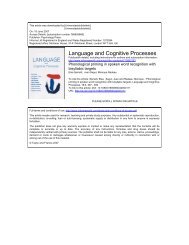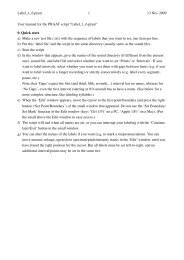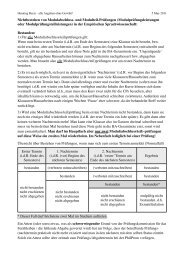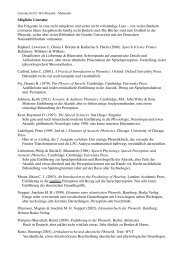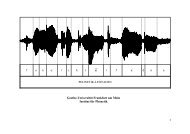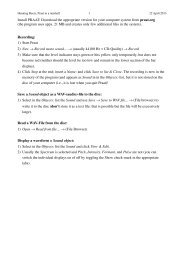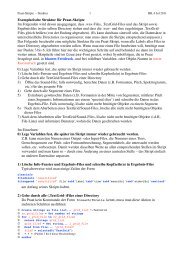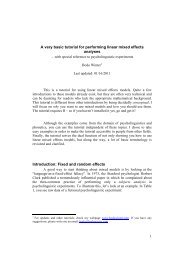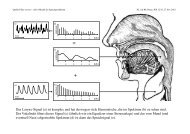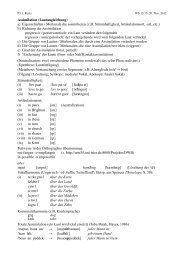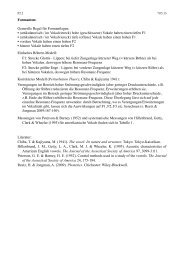Variation and assimilation in German - Institut für Phonetik
Variation and assimilation in German - Institut für Phonetik
Variation and assimilation in German - Institut für Phonetik
Create successful ePaper yourself
Turn your PDF publications into a flip-book with our unique Google optimized e-Paper software.
552 COENEN, ZWITSERLOOD, AND BOÈLTE<br />
tolerance of the word recognition system for regular variation: Lexical<br />
access is not blocked when presented with a ‘‘mismatch<strong>in</strong>g’’ feature,<br />
provided that the context segment shares this feature.<br />
No such effect is found for the progressive case of coronal place<br />
<strong>assimilation</strong>. As we argued, this agrees fully with the facts for <strong>German</strong>, but<br />
it presents a challenge for the application of underspecication theory to<br />
the speech perception doma<strong>in</strong>. Whatever rule prevents segments that are<br />
unspecied for [coronal] to surface <strong>in</strong> an assimilated way at word onset, it<br />
cannot be a general rule, block<strong>in</strong>g all variation at word onset. For we did<br />
nd effects at word onset, for legal progressive voice <strong>assimilation</strong>. Before<br />
evaluat<strong>in</strong>g the consequences of the results for the predictions that were<br />
formulated before Experiment 1, we present data from an experiment with<br />
words presented out of context.<br />
EXPERIMENT 2: CROSSMODAL FORM PRIMING<br />
IN ISOLATION<br />
Experiment 2 <strong>in</strong>vestigated the material from Experiment 1, this time<br />
presented <strong>in</strong> isolation. Accord<strong>in</strong>g to a strict view of underspecication, it<br />
should not matter whether context is present or not, but for some accounts,<br />
context is important (Gaskell & Marslen-Wilson, 1996; Gow, 2000). The<br />
empirical evidence is less clear cut. On the one h<strong>and</strong>, both Gaskell &<br />
Marslen-Wilson (1996) <strong>and</strong> Gow (2000) found signicant prim<strong>in</strong>g with<br />
assimilated tokens when the critical post-<strong>assimilation</strong> context was removed<br />
(e.g., S<strong>and</strong>ra will only eat lean/ a leam). Of course the presence of sentence<br />
context might have cued participants to the possibility of assimilated<br />
words. On the other h<strong>and</strong>, no facilitation was found for assimilated items<br />
presented <strong>in</strong> isolation (Marslen-Wilson et al., 1995), even when the release<br />
of the critical consonantal burst was cut off. Our Experiment 2 served to<br />
ascerta<strong>in</strong> whether <strong>assimilation</strong> <strong>in</strong> <strong>German</strong> requires context to be tolerated<br />
<strong>in</strong> speech recognition. As <strong>in</strong> Experiment 1, there was a complete change <strong>in</strong><br />
phoneme status between unchanged <strong>and</strong> changed words.<br />
It turned out to be impossible to create <strong>in</strong>telligible items by cutt<strong>in</strong>g out<br />
critical words from their sentence contexts. Thus, a new record<strong>in</strong>g was<br />
made. We are aware of differences between words spoken <strong>in</strong> context <strong>and</strong><br />
<strong>in</strong> isolation, such that data from Experiment 1 <strong>and</strong> 2 should only be<br />
compared with necessary caution. A forced-choice phonetic decision<br />
pretest was carried out to assess the discrim<strong>in</strong>ability of the stimuli, this<br />
time <strong>in</strong> the absence of a context word.<br />
Pretest<br />
The design was the same as <strong>in</strong> the rst pretest, except that no pseudoword<br />
pairs were <strong>in</strong>cluded. Changed <strong>and</strong> unchanged test <strong>and</strong> control words of all



